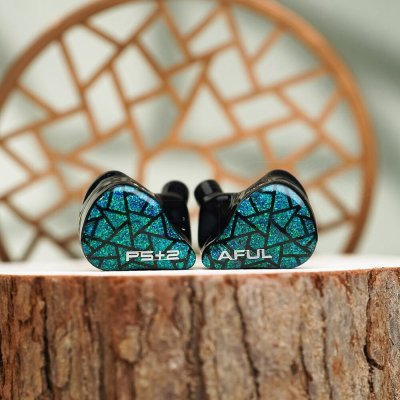Elysian Pilgrim and Aful Performer 5+2 use 1DD+3BA and 2DD+4BA+1Planar driver setups respectively. Elysian Pilgrim costs $400 while Aful Performer 5+2 costs $229. Elysian Pilgrim is $171 more expensive. Aful Performer 5+2 holds a slight 0.1-point edge in reviewer scores (7.4 vs 7.6). Aful Performer 5+2 has better mids with a 0.6-point edge, Elysian Pilgrim has better dynamics with a 0.6-point edge, Elysian Pilgrim has better soundstage with a 0.5-point edge, Elysian Pilgrim has significantly better details with a 1.1-point edge and Elysian Pilgrim has better imaging with a 0.8-point edge.
Insights
| Metric | Elysian Pilgrim | Aful Performer 5+2 |
|---|---|---|
| Bass | 7.6 | 7.7 |
| Mids | 7.1 | 7.7 |
| Treble | 7.3 | 7.1 |
| Details | 7.8 | 6.8 |
| Soundstage | 7.5 | 7 |
| Imaging | 7.5 | 6.8 |
| Dynamics | 7.6 | 7 |
| Tonality | 7.4 | 7.6 |
| Technicalities | 7.6 | 7.4 |
Elysian Pilgrim Aggregated Review Score
Average Reviewer Scores
Average Reviewer Score:
7.4Generally Favorable
Aful Performer 5+2 Aggregated Review Score
Average Reviewer Scores
Average Reviewer Score:
7.6Strongly Favorable
Reviews Comparison
Elysian Pilgrim reviewed by Gizaudio Axel
Gizaudio Axel original ranking
Gizaudio Axel Youtube ChannelBuy Elysian Pilgrim on HiFiGO
Ad
Price: $359.10
Buy Elysian Pilgrim on HiFiGO
Aful Performer 5+2 reviewed by Gizaudio Axel
Gizaudio Axel original ranking
Gizaudio Axel Youtube ChannelBuy Aful Performer 5+2 on HiFiGO
Ad
Price: $213
Buy Aful Performer 5+2 on HiFiGO
Elysian Pilgrim reviewed by Audionotions
Aful Performer 5+2 reviewed by Audionotions
Elysian Pilgrim reviewed by Jays Audio
Youtube Video Summary
Hyped for good reason, Elysian’s Pilgrim pairs a sleek, carved metal shell with a genuinely upgraded cable and a refined, clean-balanced tuning. Technicals punch high for the price—resolution sits a notch above sets like Hype 4 and Dusk, while the bass shows tight texture, tidy decay, and neat separation. The low end isn’t as forward or “full” as Hype 4, trading slam for a more neutral and organized presentation that suits listeners seeking clarity over thump.
Vocals are naturally placed: not shouty, not distant, with a touch of air on the tail that avoids harshness. Compared with Dusk, the Pilgrim carries better upper-mid extension and a more complete, detailed midrange; it’s also a bit smoother and more natural up top, and adds a hair more sub-bass for engagement. As a package—sound, build, and unboxing—the Pilgrim reads like a polished, modernized take on that classic balanced recipe.
Context matters, though. As an all-rounder around $300–$400, Pilgrim would be an easy pick, but the Supermix 4 at ~$150 offers roughly “90% of the experience” with an even smoother tilt, pressuring its value case. On the horizon, Simgot EM10—if priced around $399–$450—promises more air, detail, punchier mid-bass, and a wider wrap-around stage, potentially overshadowing Pilgrim’s more chill, laid-back vibe. Practical notes: no obvious channel imbalance was heard, but the ring plating can scratch quickly, the fit is a bit shallow, and wider-bore tips help. Net: a beautifully made, balanced performer for those who value refinement and design, but with fierce competition today, some shoppers may prefer to wait or choose something more specialized (e.g., Hype 4 for bigger low-end).
Jays Audio Youtube Channel
Aful Performer 5+2 reviewed by Jays Audio
Youtube Video Summary
Performer 7 lands with a neutral-balanced, laid-back tuning and good treble reach. The presentation is clean and generally safe, though there’s a touch of sizzly “planar-ish” timbre up top. Technicals are solid for ~$200—slightly behind sets like Quintet and Super Mix 4, about on par with Nova. Bass from the dual 6 mm DDs is tight, controlled, and free of bleed, but lacks the slam and rumble of competitors using larger drivers; mids are well separated with decent layering.
The weak spot is vocal extension: a push around 1.5 kHz tries to bring them forward, but a dip through 3–6 kHz keeps them from opening up. Tamer upper-mids help avoid fatigue for rock/metal, yet the modest low-end impact leaves drums and basslines feeling uneventful. It’s a mid-volume set that doesn’t scale well—turning it up accentuates the 1.5 kHz emphasis and treble sizzle. Treble isn’t peaky, just a bit glassy at times; for K-pop the smoother mids can work if less extended vocals are acceptable.
As a value play, there are stronger options: Nova, Chopan, and Super Mix 4 offer better bang-for-buck; for a similar clean/neutral target, Tanchjim Origin sounds more natural with better bass texture and vocal reach, and DynaQuattro adds sub-bass and fuller vocals—none with the planar-ish timbre. Even AFUL’s own P5 is cheaper and more fun, while the Explorer undercuts the price and scales impressively. In today’s crowded market, P7 is a competent all-rounder but not distinctive enough to stand out.
Jays Audio Youtube Channel
Elysian Pilgrim reviewed by Jaytiss
Youtube Video Summary
Elysian’s Pilgrim shows up with a small, comfortable shell and a tidy, premium-feeling case—white on the outside, a bit papery inside, but practical. Fit leans shallow; a grippy tip helps keep things steady. The unit measured with excellent channel matching and tracks closely to a preferred target, setting the stage for a confident first impression.
On sound, Pilgrim delivers punchy bass with real note weight and slam, natural mids, and imaging that locks in place. There’s a touch of metallic/lush timbre and an ear-gain region that can feel a bit forward, but the overall tonality stays engaging. It’s not a “baby Annihilator”: the big sibling still brings deeper sub-bass and a cleaner upper register, while Pilgrim feels a little more fun and lively. Versus Hype 4, the two trade blows—late vs. early ear gain—with Hype 4 getting a slight nod for some tastes; against the Mega 5 EST, Pilgrim is the more exciting listen and, at roughly $150 less, the stronger value.
Ranking wise, Pilgrim sits among the best at its price, even sparring with costlier sets, though it stops short of heavy hitters like Grand Maestro, Annihilator, Jupiter, or Velour. Assuming the rumored $350–$450 bracket, the package—sound, cable, and case—is compelling. Minor quirks in the ear-gain area aside, this is an exceptional IEM with a full recommendation, and there’s even a Noir version on the horizon for those curious about variants.
Jaytiss Youtube Channel
Aful Performer 5+2 reviewed by Jaytiss
Youtube Video Summary
Aful Performer 5+2 lands as a hybrid of the beloved Performer 5 and the punchier Explorer. The unboxing is the familiar P5 affair—same case, same style of tips—nothing flashy, but solid. The shell mirrors the P5 in size with a comfy little stabilizing wing that locks in well. No metal nozzle or front filter here, yet tip retention is secure and hassle-free. The flat 2-pin socket is straightforward, and the stock cable feels thick and supple with a reliable chin slider and handy red/blue channel markers. Overall: understated build, great ergonomics, daily-driver ready.
Sonically, this one aims neutral with a very distinct top end—clean, dynamic, incisive. Think switching from black-and-white to color; cymbals and overtones pop with a slightly crunchy/pristine edge that energizes detail without turning harsh on good recordings. Bass isn’t about sheer quantity; it’s about slam and dynamics—quick on the draw, well-controlled, and satisfying when called upon. Vocals sit a notch forward, microdetail is strong, and the overall presentation is coherent, clear, and technical with convincing stage, resolution, and imaging. Not a treble-shy or bass-bombed tuning—more a refined all-rounder for those who want clarity and bite.
Versus the original P5, the 5+2 fixes the missing “air” and soft edges, trading them for crisper transients and better extension. Compared with Explorer (a value champ), the 5+2 brings superior upper-treble reach, detail, and vocal focus. Against Performer 8 and Cantor, it feels more visceral—the P8 is smoother and more relaxed, while Cantor pulls finer microdetail but with less bass slam. Sets like Dino Quattro or J’s Estrella bring bigger fun or treble theatrics, yet the 5+2’s balance and everyday versatility win more often. Net take: a neutral-leaning, highly technical upgrade that stands tall in its bracket—easy to recommend to anyone chasing clarity, speed, and controlled impact over pure warmth or excess bass.
Jaytiss Youtube Channel
Elysian Pilgrim reviewed by Z-Reviews
Youtube Video Summary
Elysian Pilgrim hits the rare $400 bracket with a hybrid recipe—1× LSR dynamic and 3× Sonion BA—and a presentation that pulls the stage in. Instead of big, floaty width, the image clamps down with laser focus: vocals and transients sit right there, almost “under the skin.” Well-recorded tracks pop with mic-placement clarity; poorly recorded ones get called out instantly. Bass is punchy and structurally correct rather than boosted—not a basshead set, but it thumps when the mix calls for it. It scales across amps (from clean to tubey), with some chains teasing a bit more soundstage while keeping that intimate, hyper-detailed character.
Build is slick: a comfortable, not-too-thick shell with a machined aluminum back and proper venting. The star quirk is the Pentaconn Ear connector—rotational like MMCX but far more robust—which also means most existing cables won’t fit, so the stock cable (often 4.4 mm, with 3.5 mm or both for extra) becomes the default. The earhooks curve a bit aggressively but can be reshaped; comfort overall is easy listening. Accessories are fine but not lavish: SpinFit tips and a big showpiece case that’s cool, if not pocketable.
Sonically it’s a “punch-drunk focus” specialist: drives through track after track, rewards great recordings, and refuses to sugarcoat weak ones. The Pilgrim feels special because of that concentrated energy and neutral-honest bass—more “truth serum” than lounge lizard. Verdict: 9/10. Docked for cable ecosystem quirks and a modest accessory spread, but the sound is compelling enough to make that nitpicking feel small. Curiosity about the pricier Pilgrim Noir stays high, yet this standard model already delivers a distinctive, addictive ride.
Z-Reviews Youtube Channel
Aful Performer 5+2 reviewed by Z-Reviews
Youtube Video Summary
Naming drama aside (P5+2? just call it Performer 7), this Aful packs a quirky driver party: 2DD for low end, 4 BA split across mids/treble, plus a tiny micro-planar for the highest sparkle, all marshaled by Aful’s neat miniature crossover. The shells are lightweight, comfy and prettier than they need to be; the cable feels “don’t bother swapping” nice, with 3.5 or 4.4 options. The box is loaded with silicone tips but no foam—a miss, because the right seal changes everything. Price target sits around $250, which sets expectations high but not ridiculous.
Stock silicone yields a surgical, respectful tuning with bass that skews neutral and controlled. Swap to well-sealing foam or hybrids and feed a juicy source (warm Class A or tubes) and the set wakes up—stage snaps into a cohesive scene right in front, imaging gets laser-etched, and that micro-planar adds a pinch-of-salt treble spice without turning harsh. It’s an up-close presentation—sometimes almost claustrophobically detailed—in the best way: think “men with trumpets in the head,” precise placement, and excellent extension up top. Not as rowdy as the Explorers; more like a surgeon in a Hawaiian shirt—technical, but with a wink.
Practical upside: the clarity and positioning make this great for gaming and even viable for mixing/mastering checks; just don’t crank it into pain territory. Bass stays tight and responsive, treble sails high, and coherence holds. Tip and source matter a lot: with foam + warm power, it sings; with plain silicone, it’s merely polite. Final tally: a confident 8.5/10—doing a lot right at its price, dinged half a point for making everyone do math on the name.
Z-Reviews Youtube Channel
Elysian Pilgrim reviewed by Tim Tuned
Youtube Video Summary
Elysian Pilgrim hits that rare sweet spot: a truly affordable entry into the brand’s house sound that still feels flagship-adjacent. Think Gaia DNA with a more tamed signature—the bass is dynamic, punchy, thumpy yet modest in quantity, staying clean with no bleed into the lower mids. Vocals sit center-stage with a touch of thickness, generally natural timbre and only a hint of grain that comes from the energetic top end. It’s a balanced, non-boomy low end for everyday listening; bassheads may want +1–2 dB more.
The star is the treble: incisive, nuanced, and genuinely “end-game” in detail retrieval at this price. Treble quality tracks closely with Gaia, still shy of the Annihilator, but astonishing for $399. Overall technical performance is the wow factor—notes feel crisp, tactile, high-definition, sitting well above sets like the Blessing 3 while only lightly trading away smoothness, and doing so tastefully. It reads as a “high-res” listen without slipping into harshness.
Against peers: Studio 4 stays smoother and more natural, but Pilgrim brings more energy and clearly higher detail. Versus the Hype 4, the latter has more bass quantity, yet Pilgrim wins in treble timbre and overall resolution. Compared with Moondrop x Crinacle Dusk, rankings shake out with Pilgrim first in treble and technicals, while the DSP Dusk often leads for bass/vocals over the analog version. Verdict: a big green thumbs up—an A+ for delivering thrilling, highly technical performance that competes above its class. (Interview notes: the Pilgrim Noir variant aims warmer, includes an Eros S cable and luxe case at a higher price, while standard Pilgrim stays the brighter, value-focused pick.)
Tim Tuned Youtube Channel
Aful Performer 5+2 reviewed by Tim Tuned
Elysian Pilgrim reviewed by Super* Review
Youtube Video Summary
The Elysian Pilgrim brings boutique flair to a more reachable $400 tier with a metal shell that mixes matte and glossy milling, a comfy medium fit, and a plush two-core cable that’s nicer than most in the class. Notable is the Pentaconn connector—smooth to rotate and said to be durable—though cable swapping is less convenient if the stash is mostly 2-pin/MMCX. Accessories feel thoughtful (including unique black-core SpinFit tips), while the case skews a bit large.
Sonically it’s a well-balanced, slightly midrange-focused tuning with a clean sub-bass lift (below ~150 Hz) that can read “bass-light” on tracks heavy in mid-bass. Treble isn’t pushed; presentation comes off a touch brighter/open than the curve suggests, with solid imaging and agreeable vocal clarity. Compared to an earlier show demo, the production unit’s top end feels nerfed: those delicate, Plucky treble transients and the weight in high-hat percussion that once stood out are dialed back for a safer listen.
In the $400 cohort—Yanyin Canon 2 (warm, meaty), Thieaudio Hype 4 (leaner mids, thicker bass), Moondrop Dusk (clinical neutral with sub-bass and forward vocals), and Softears Studio 4 (brightest, most lively)—Pilgrim slots squarely mid-pack: agreeable, but less distinctive than the more characterful peers. Had the show tuning shipped, it would spar closer to the front; as is, the take is competent yet conservative. Final verdict: three stars out of five—a quality set that favors balance over excitement in an increasingly competitive bracket.
Super* Review original ranking
Super* Review Youtube ChannelAful Performer 5+2 reviewed by Super* Review
Youtube Video Summary
Aful’s Performer 5+2 upgrades the original hybrid with 2DD + 4BA + 1 micro-planar tweeter and lands around $240–$250. The unboxing is practical: three sets of silicone tips, a pocketable puck case, and a soft, nicely draping cable (available in 4.4 or 3.5), though the braid can look a bit loose and the pre-formed hooks run large. The resin shells shift between blue and green under different light; fit is medium-large, very stable, and comfortable once the right tips are found. Note the narrow nozzle without a retaining lip and partially exposed bores/filters—tip grip is key and a little care prevents ear-gunk ingress.
Tonally this leans mild V-shaped: a clean midrange with a confident bass boost, a touch of lower-treble presence for bite, and well-extended air up top. The result is more incisive and punchy than the original P5, with clearer on/off transients that aid separation and layering. Trade-offs show as a hint of gritty/plasticky treble texture on cymbals and brushes—not harsh, but less natural than ideal—while the bass stays tight and exciting.
Against Aful’s Explorer, this sounds brighter, more spacious, and more technical; Explorer plays warmer/denser with smoother treble but less openness. Versus the pricier Thieaudio Oracle MK3, tuning is broadly similar: Oracle is smoother and deeper with a softer attack, while the Performer 5+2 brings more snap and engagement for less money. As a modern mid-tier hybrid, it absolutely still has a place—energetic, spacious, and well-executed—earning a solid four stars.
Super* Review original ranking
Super* Review Youtube ChannelElysian Pilgrim (more reviews)
Elysian Pilgrim reviewed by ATechReviews
Youtube Video Summary
The Elysian Pilgrim OG comes across as the more open, energetic and value focused tuning in this duo. Its sub bass reaches very deep with excellent texture and detail, giving EDM and cinematic tracks a satisfying rumble, while the mid bass remains more restrained than on the Noir, prioritising definition over sheer weight. The midrange sits clearly in the spotlight, with vocals placed firmly in the centre and benefiting from the airy treble, so singers and instruments cut through the mix with impressive clarity.
Treble is one of the strongest cards for the Pilgrim OG: there is plenty of air and subtle sizzle up top without crossing into harshness, giving cymbals and high frequency effects a crisp halo and enhancing the sense of openness. Detail retrieval, instrument separation and soundstage sit at a level that legitimately challenges far more expensive sets, making it easy to pick out layers in busy mixes and giving the presentation a spacious, high resolution feel. Despite the slightly leaner mid bass, the overall tuning feels balanced, engaging and controlled rather than thin.
Where the Pilgrim OG truly stands out is value: the combination of technical performance, engaging tonality and solid build quality creates a package that comfortably challenges IEMs well above its price bracket. For listeners who enjoy a clean, open and resolving signature with strong sub bass, vivid mids and airy treble, the Pilgrim OG remains the clear pick over the Noir, trading a bit of warmth and relaxation for extra clarity, spaciousness and that addictive upper treble sparkle.
ATechReviews Youtube Channel
Elysian Pilgrim reviewed by Yifang
Elysian Pilgrim reviewed by Shuwa-T
Elysian Pilgrim reviewed by Smirk Audio
Elysian Pilgrim reviewed by Head-Fi.org
Aful Performer 5+2 (more reviews)
Aful Performer 5+2 reviewed by Audio Amigo
Youtube Video Summary
The AFUL Performer 5+2 (Performer 7 / P7) takes the P5 recipe and adds a second 6 mm dynamic for the lows and a micro-planar for the highs, nudging MSRP to $240. Unboxing mirrors the P5: nine pairs of tips and a decent case, but the accessories feel bare-bones at this price—no foam tips and a non-modular cable, even though the included 8-wire is supple and well-behaved. Build is classic AFUL: 3D-printed resin, blended nozzle (no mesh or lip—watch tip retention), single rear vent, and striking blue-green mosaic shells inspired by Suzhou gardens—cool-wall approved with four compliments to one “meh.” Fit is semi-custom and a touch chunkier than P5; comfortable for most, a conditional pass for small ears. Note a sporadic batch quirk: some units have over-tight 2-pin sockets; exchanges fixed it for affected buyers.
Tuning sits in warm-leaning neutral territory. The dual dynamics deliver punchy, textured bass that rumbles without bloating; guitars and drums carry convincing weight. Mids are the star—rich, full-bodied, vocal-forward without shout, with clean separation and natural tone. Treble from the micro-planar is smooth yet energetic: cymbals and vocal harmonics sparkle, special effects have bite and body, and only treble-sensitives may find hot mixes a bit lively. Technicalities impress for the money—detail retrieval and nuance feel a class up—while stage and imaging are solid rather than showy.
Against peers: the Tangzu x HBB budget pick mirrors the overall tonality but P7 offers higher resolution and more treble finesse; the planar “Heyday” alternative is brighter/faster with leaner bass; versus Performer 5, P7 brings tighter low-end, smoother treble, and better extremes detail; the Fresh-collab competitor pushes vocals further forward with bigger stage but leaner lower mids. Verdict: a versatile all-rounder that suits broad libraries and even content creation thanks to its balanced tonality and detail. Not for bassheads, trebleheads, or strict Harman-lean seekers, and the accessory pack/cable quirk holds it back from a slam-dunk. For roughly $240, though, it’s a brilliant, resolving upgrade in the AFUL line.
Audio Amigo Youtube Channel
Aful Performer 5+2 reviewed by Kois Archive
Kois Archive Youtube Channel
Aful Performer 5+2 reviewed by Paul Wasabii
Youtube Video Summary
The AFUL Performer 5+2 takes the familiar hybrid recipe of dual 6 mm dynamics, four balanced armatures and a micro planar and spins it into a distinctly vocal focused presentation. Vocals are pushed very close, giving an intimate, close talker character that will immediately stand out from more typical U shaped hybrids. This forwardness comes at a cost, as the overall soundstage feels flatter and smaller than many competitors, with the midrange taking center stage at the expense of a more spacious image.
The dual 6 mm drivers deliver a sub bass tilted low end that has respectable rumble and enough level to support genres that appreciate extra weight, while avoiding obvious boom or bloat. Impact and tactility are on the softer side, and combined with the elevated midrange and treble, bass presence tends to sit very close to the vocals rather than carving out its own layer. This crowding effect, together with the warm, smoothed textures, means layering and separation never really open up, giving the Performer 5+2 a more compact, blended presentation than many modern tribrids.
The treble region is where the tuning feels least controlled, with peaks across the upper mids, presence and air bands that can bring out snare hits and sibilants and push the micro planar into an overdriven, slightly unnatural timbre. The intended advantage of the micro planar is largely lost in this boost, keeping overall technicalities such as detail retrieval, imaging precision and stage depth firmly in the moderate camp rather than a clear step up from AFULs other models. As a result, Performer 5+2 emerges as a niche choice for listeners who strongly prioritize upfront vocals and do not mind a smaller, more intense stage, while those looking for a more balanced, spacious and natural presentation will likely find better options elsewhere.
Paul Wasabii Youtube Channel
Aful Performer 5+2 reviewed by Web Search
The AFUL Performer 5+2 (also listed as “Performer 7”) uses a 2DD+4BA+1 micro planar driver array and AFUL’s LC-network crossover plus a 3D-printed acoustic tube system, aiming for clean band splits without smearing. The shell also integrates a high-damping air-pressure balance system, a design AFUL has used across its line. Official listings put MSRP around $229 and outline the same core tech features.
Tonally it trends neutral with a sub-bass lift: bass has solid depth and texture, mids stay relatively linear, and the presence/treble region adds energy without veering into sharpness on most chains. Multiple reviews characterize it as warm-neutral with bass boost or slightly V-shaped depending on perspective, which matches listening notes about a lively but controlled upper end. Sensitivity and load are portable-friendly (≈109 dB, 15 Ω), so it reaches performance without demanding amplification.
Technicalities are competitive for the class: imaging is tidy with good instrument separation, micro-detail retrieval is above average, and soundstage is moderate (more width than depth). Build and comfort are typical resin-shell fare; some users note occasional lower-treble bite depending on tips and recordings, so treble-sensitive listeners may wish to pair accordingly. Overall value is strong at its price, especially if a clean, bass-supported neutral curve is the priority.
Elysian Pilgrim Details
Driver Configuration: 1DD+3BA
Tuning Type: U-Shaped
Brand: Elysian Top Elysian IEMs
Price (Msrp): $400
Support our free service! Buying through our affiliate links costs you nothing extra:
Aful Performer 5+2 Details
Driver Configuration: 2DD+4BA+1Planar
Tuning Type: Neutral with Bass Boost
Brand: AFUL Top AFUL IEMs
Price (Msrp): $229
Support our free service! Buying through our affiliate links costs you nothing extra:
Elysian Pilgrim User Review Score
Average User Scores
Average User Score: n/a
Based on 0 user reviews
No user reviews yet. Be the first one who writes a review!
Aful Performer 5+2 User Review Score
Average User Scores
Average User Score: n/a
Based on 0 user reviews
No user reviews yet. Be the first one who writes a review!
Elysian Pilgrim Gaming Score

Gaming Score & Grade
- The gaming score is prioritizing technical capabilities of the IEM (Separation, Layering, Soundstage) and good value.
Gaming Score
7.3Gaming Grade
A-Aful Performer 5+2 Gaming Score

Gaming Score & Grade
- The gaming score is prioritizing technical capabilities of the IEM (Separation, Layering, Soundstage) and good value.
Gaming Score
7.5Gaming Grade
AElysian Pilgrim Scorings
Average Technical & Tuning Grades
Average Tunign Grade
A-- It balances warmth and clarity well, showing only minor quirks along the way. Timbre feels believable with most instruments.
Average Technical Grade
A- You get a well-rounded technical package that keeps separation, detail, and staging in harmony. It's a solid middle ground between fun and fidelity.
Aful Performer 5+2 Scorings
Average Technical & Tuning Grades
Average Tunign Grade
A- Tuning feels well executed, keeping a natural flow across the spectrum. Switching genres feels seamless.
Average Technical Grade
A-- It manages detail and layering well enough, even if the stage feels only moderately sized. You get a clear sense of left and right, if not depth.
Elysian Pilgrim User Reviews
"This is an example review"
Pros
- Example pro 1
- Example pro 2
Cons
- Example con 1
- Example con 2
Share your experience and build your personal ranking list.
You need to be signed in to write your own reviewAful Performer 5+2 User Reviews
"This is an example review"
Pros
- Example pro 1
- Example pro 2
Cons
- Example con 1
- Example con 2
Share your experience and build your personal ranking list.
You need to be signed in to write your own reviewFind your next IEM:
IEM Finder Quiz
newIEM Comparison Tool
newVS
































